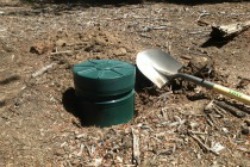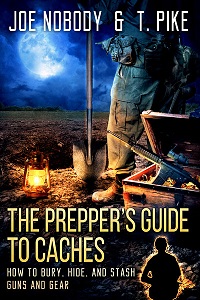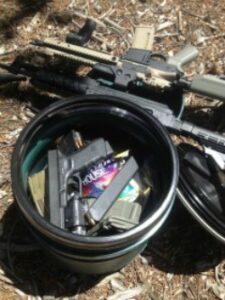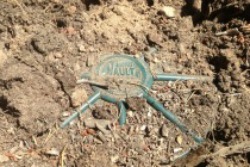
Is there a compelling reason to justify selecting, creating, and stocking a back up supply hide? This is a subject I have spent considerable time researching over the past several months. My conclusions are not hard and fast, because I realize first and foremost that every member of the SHTF Blog family has different survival prep priorities, goals and objectives. Creating another survival cache of goods is not for every prepper. And don’t be confused by my use of the terms secondary or intermediate, because I mean them to be interchangeable.
Why Create Other Cache Hides?

Here’s the scenario. You work downtown in a medium or large city. The commute is several miles from home and it takes up to an hour depending on the traffic congestion to get to your office or work site. Your wife and kids work and go to school in the opposite direction. By noon there is a report of severe weather coming in. A glance out your office window reveals dark, ominous clouds rolling in your direction. It is obvious the winds are picking up and it starts raining. What do you do?
You call your wife and tell her to gather the kids and head to your predetermined secure Bug Out location, which is a rural farmhouse built to withstand nasty storms. When you finally negotiate the traffic and arrive at your Bug Out locale, what have you done to prepare at that site for an extended stay? Did you cache out the site?

Scenario No.2 is different. You live downwind only 40 miles from a chemical plant that has experienced a melt down. You have been ordered to evacuate your home and you have zero time to pack anything. The whole thing catches you off guard. You gather your family, jump in the SUV and speed down the driveway praying you can find a motel somewhere down the highway in the safe zone. The nearest town is another fifty miles down the road. Perhaps you wish you had stashed a cache of supplies somewhere else away from your home just in case? Maybe just a hidden plastic sealed vault with some emergency food, water, medicine, and some other supplies to carry you over.
Obviously we could create an endless number of “what if” SHTF scenarios in which the creation of a secondary supply cache would have proven extremely beneficial. Questions arise about where, what, how much, how long, and such. It seems as though some of these questions could prove quite problematic to having a secondary cache. I guess the question will always remain just how practical it would be to build out a secondary supply hide. For me, the tough issue would be setting aside critical supplies in a potentially vicarious location where expensive goods might deteriorate over time or be discovered by somebody else or even be gone when I needed it.
Some would say to cache out at a distant family or friend location where it would be secured. Others advocate the extreme of burying it somewhere in the wilds hoping it will endure the natural elements. All questions worthy of poised thought and planning. But for the sake of consideration for proper prepper planning, let’s consider the possibilities.
The Cache Bag

Perhaps this could be considered nitpicking, but what if we created a smaller version of a Bug Out Bag that contained perhaps some of the same stuff, but in smaller emergency type quantities that we could cache in one or more locations for “on the run” situations. This would be an intermediate grab and go bag on our way to a more permanent Bug Out location. It could be buried in a waterproof gun burial tube or some other device.
It is not to be kept at your fixed home living domicile, though I suppose it could be in the car trunk or in the back of the SUV. The idea though is for it to be hidden out at an in between location from Home A and Bug Out Location C. The Cache Bag is posted at Site B. The location could be a friend’s garage, a known business location such as a warehouse of an associate, or the upstairs closet of an aunt somewhere along the travel route. There could be multiple Cache Bags hidden at alternate routes all eventually leading to your final Bug Out hold out.
These supplies are meant to sustain you until you reach your final pre-planned destination during the SHTF. This would differ from larger Bug Out Bags that would be intended for an extended starter supply bag once you traveled direct from your home or office to the Bug Out site. This Bug Out Bag would be kept at home or in the vehicle if secure. The Cache Bag idea is also not a substitute for well supplying your final Bug Out locale in advance. I realize this is taking a fine line, but one principle of prepping is to remain flexible and to consider multiple options. Frankly, we’ll never really know what options we have until we’re in the middle of it hitting the fan.
Packing a Cloaked Hideout Cache

One has to realize in this day and age that we could be displaced from our homes sometimes on very short notice as a result of any number of circumstances such as the examples opening this treatise. If we are away from our primary residence at that time, then we may realistically not have time to gather supplies or essentials for our evacuation or escape. We may need gear, supplies and equipment hidden elsewhere either before we can get to our Bug Out site or as an alternative to that Bug Out site.
Such a cache is meant to be hidden long term and retrieved in the event of a SHTF. As mentioned above there could be many options for hideout places. You have to pick ones you are secure about and comfortable with. What sort of goods should we plan to pack into a hideout cache?
The list should be kept short, concise, and focused on essential needs. One list might include some clothing items geared toward seasonal weather, everyday use toiletries such as a toothbrush, toothpaste, deodorant, soap, shampoo, a comb or brush, wet wipes, washcloth, small towel, some cash and coins, perhaps some candy, energy bars, and some water. Consider a shelter top, tarp or heavy duty plastic leaf sacks. Other items worthy of consideration to cache based on an assumption that your evacuation might be due to a natural disaster that could have possibly destroyed your home, neighborhood, or town and thus you could suffer the loss of critical items like important documents.
You might want to strongly consider copies of credit cards, essential keys such as duplicates for your vehicles and house, insurance papers, social security cards, banking information and account numbers, and critical personal files you might wish to copy onto a flash drive. Any other personal important items as well perhaps birth certificates, legal papers, your will, home mortgage information and titles to your house and cars. Pack a supply of any required medications and perhaps some over the counter items such as aspirin, Ibuprofen, acetaminophen, antacids, and any other items you may normally use on a regular basis.
All of these items could be cached securely in a 58-gallon molded survival barrel with a waterproof screw on top. These containers are available from many sources and could be buried or just well hidden. There are many other products out there as well to be used for caching supplies, gear, and goods for a long term storage plan.
Maybe What Not to Cache

Personally I am a bit squeamish about packing weaponry and ammo in an intermediate hideout cache. I want that kind of gear with me the entire time. A few extra boxes of ammo maybe, but I’m not putting an AR or a pistol in a ground vault. You may decide otherwise. Check shelf life on food products you cache. A number of MRE meal packs would be good and expected to last a while. Store bought granola or energy bars may not last that long. A few bags of purpose-driven survival food would work. Again the idea (hopefully) is for this secondary cache to just tide you over in route. You decide how many days of rations and supplies you want to hide out.
It is reasonable to consider that any SHTF escape plan could be interrupted, altered, compromised, or become a dead-end effort. You may have initially worked out a plan to get from Home A to the final Bug Out site C in two days. What if the roads are blocked, gangs or zombies are controlling or raiding points of exit. It might take you to alternative routes and a much longer protracted scenario to reach safe haven.
Start setting seconds of gear, goods and supplies aside to build out your cache bag. Keep focused on the idea that this is not your final destination so it is not imperative to put your best stuff in a secondary hideout location. Save the best stuff for your more permanent bug out location.
I hope you guys can think of a cajillion (that’s more than a million!) other things to put into a secondary cache. We are counting on your thoughts to supplement ours. Use our comments section to post your ideas and suggestions. We are all in this together so please share your lists.
Photos By:
John Kercher

6 comments
Great article. I’ve done a few “time capsules” in various areas that make sense to me. A few recommendations… Air tight, DESICCANTS, DESICCANTS, DESICCANTS, and heat shrink wrap your tubes/boxes. Also, when you burry them, “chaff” the area with some junk to throw off the metal detector happy vacationeer and treasure hunter. Another recommendation is have two different sets… ultra secret personal, and “soup from a stone” containers filled in prepping parties in your trusted group. They should also be checked on from time to time to insure no surprises.
The “chaff” cannot be random. Modern detectors can discriminate between metals and item size and depth. If the chaff does not match all the detector’s identified metals, or depth is wrong, any detectorist worth his/her salt would just ignore the chaff and keep digging.
The best option is to go below the detector’s range. Three feet ought to do it. But that’s three feet to the nearest metal. If your cache container is plastic, and the nonmetallic items are at the top, then measure your highest metal as the depth point in your burial.
Something to think about before trying this: If you dig a hole on any federal land it is a FELONY and is automatically investigated upon discovery by the FBI.(NO S*** look it up) If you place your “cash” on ANYBODYS land but yours you are not only trespassing, and a vandal but everything in that cash AUTOMATICALLY becomes the legal property of the land owner or the government in most states as ABANDONED PROPERTY. Also in most of the rural south going onto somebody’s farm and burying things might get you shot. It will shit sure send you to jail, and if you do this on ANY federal land could brand you as a federal felon. That would put a real dent in your OPSEC, Now wouldn’t it?
Remember that .50 cal that was found cached outside Salt Lake City prior to the Olympics?
From the newspaper:
“Despite his assurance that the Salt Lake City games will be the “safest place on earth,” Utah Gov. Mike Leavitt was scrambling to defend security preparations after the discovery of a high-powered sniper rifle stashed in the hills above an Olympic skiing venue.
A man hunting coyotes found the weapon along with 386 rounds of ammunition in a green metal box marked “explosives” on Jan. 26.”
Most likely the owner was hiding it from his wife(s). Considering its condition I bet it was a Y2K stash.
I really like the idea. I have done some cache’s and plan on more at various homes/properties of friends. One plan is to bury a 5G bucket with the basics ( 10 C’s) no food, due to critters, out in the woods. It is off the beaten path and should be never found. I will keep it non-lethal, sans knife, but full of good stuff. A pack, clothes, shelter, and the like can make E & E much easier. One aspect of this that doesn’t get much press, due to trust issues, is stashing stuff at friends houses. I keep stuff for them and vice versa. If you don’t have people you can trust, well, it sucks to be you.
I have several 6-gallon, plastic, air-tight buckets that I use for caches buried at different directions of the compass because you never know where a threat (man-made or natural) will come from! I include #10 cans of freeze-dried (FD) food and 10C items! I don’t keep personal info or toiletries in them because the first can used against you and the second only wastes limited space. I do include weapons because you could be forced to flee with only the ‘shirt on your back’ (SOYB!)! GLAHP!